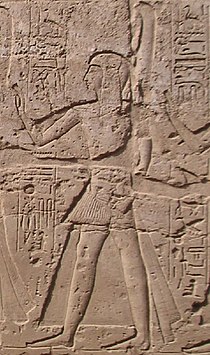Ramesses (prince)
| Ramesses in hieroglyphs | |||||||
|---|---|---|---|---|---|---|---|
Ramesses |
|||||||
Ramesses |
|||||||
| Prince Ramesses at Luxor | |||||||
Ramesses (sometimes referred as Ramesses B) was an Ancient Egyptian crown prince during the 19th Dynasty.
Ramesses was the eldest son of Ramesses II's and Queen Isetnofret, and the second son overall after Amunherkhepeshef, the eldest son of the Great Royal Wife Nefertari. Born during the reign of his grandfather Sethi I, he had at least one sister and two brothers. His sister Bintanath was elevated to the position of Great Royal Wife later in the reign of Ramesses II and played an important role at court. A possible sister named Isetnofret may have married her brother Merneptah and been his queen, however, it is possible that Merneptah's queen was his niece, not his sister. His known younger brothers are Khaemwaset and Merneptah. Ramesses is listed on several monuments with his younger brothers Khaemwaset and Merenptah. He appears as the second prince in the list of procession of Ramesses' sons in Luxor and Abu Simbel.
He is attested in numerous inscriptions including the Egyptian 'triumph' scenes after the Battle of Kadesh. Ramesses bears the titles of Royal scribe, Generalissimo and "bodily King's Son beloved of him", and is shown presenting the "Maryannu-warriors of the despicable Naharina" to the gods as spoils of war. In scenes from the battle of Qode in year 10 at Luxor, the princes Amunherkhepeshef, Ramesses, Pareherwenemef and Khaemwaset are shown leading prisoners before their father the king.
Ramesses is depicted as just one of two princes depicted by the colossi of Ramesses II in front of the Great Temple at Abu Simbel. He appears in front of the colossus to the north of the entrance. Prince Ramesses is said to be the Royal Scribe and first Generalissimo of His Majesty, Bodily King's Son (of his body).
...
Wikipedia

